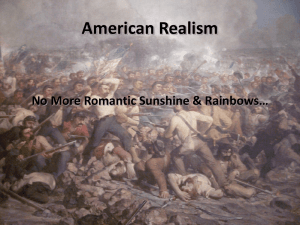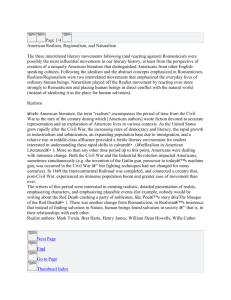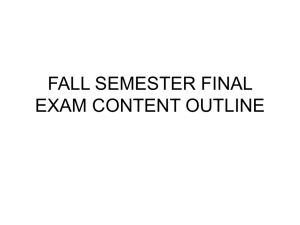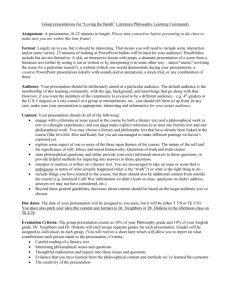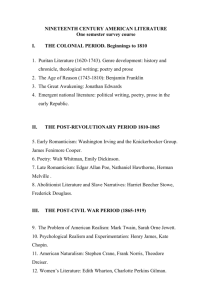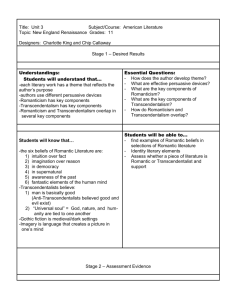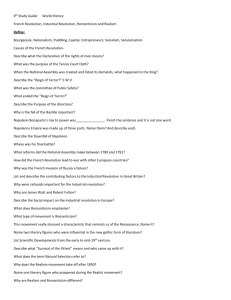Literary Analysis
advertisement
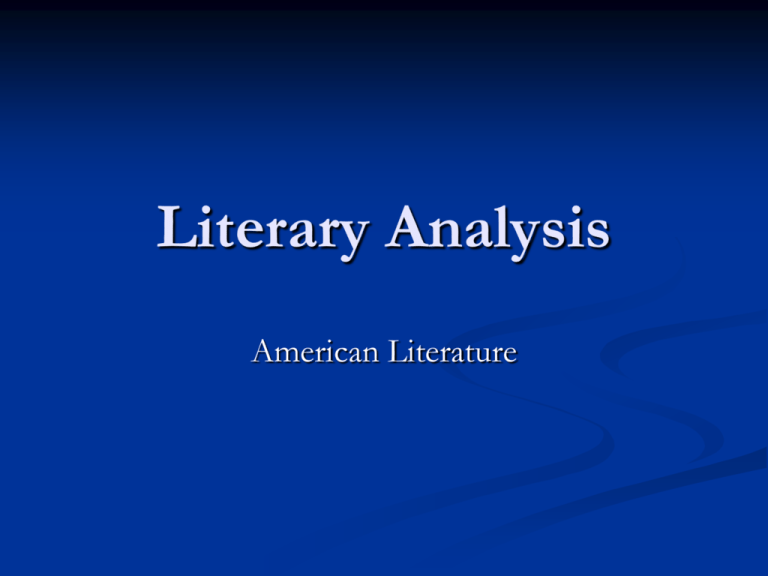
Literary Analysis American Literature Literary Analysis Choose at least one Literary period American Romanticism: 1800-1840 Transcendentalism: 1820-1860 Dark Romantics: 1840-1860 Realism: 1865-1900 Modernism: 1900-1940 Literary Analysis Choose at least one example from each period Romanticism: Transcendentalism: Dark Romantics: “The Legend of Sleepy Hollow” Romantic Poetry “Nature” Walden Poetry of Whitman Poetry of Poe “Young Goodman Brown” “The Black Cat”/ “Masque of the Red Death Literary Analysis Choosing the texts (continued) Realism: Bridge” “Celebrated Jumping Frog… “On the Damned Human Race” “An Occurrence at Owl Creek “The Real Thing” Literature of Fitzgerald: “Babylon Revisited” “Winter Dreams” The Great Gatsby Philosophical Descriptions Romanticism Heroes: were larger than life; led simple lives; were morally strong; had high ideals; were somewhat untamed but adaptable, avoided “city” life; women usually represented domestication. Themes: focused on the Truth of life, highlighted moral constants and simplicity, honesty; clash between modernization and traditions, rural vs. urban. Settings: were usually in the “past” and/or in the untamed wilderness that tested the main characters. Usually showed the profound differences between rural life and industrialization. Philosophical Descriptions Transcendentalism Themes: focused on the internal struggle to the attainment of Truth, serenity, morally sound thinking. There is a belief in a Divine Soul/God and that man must forever struggle to find this “purpose”. Education, Freedom, Equality, are all valuable. Settings: almost all literature focuses on the value of untamed Nature. It is through the inner-workings of Nature that man can find the Divine Soul. Characters: although few works of fiction are Transcendental, the essays, poems, etc. usually focus on simple characters, who strive for perfection through hard work and discipline and a communion with Nature. Individuals are simple and self-reliant. Philosophical Descriptions Dark Romantics: Themes: similar to Romanticism, these stories usually focus on some moral issue. The difference is the Dark Romantics see the evil in the world as very tempting and prevalent. These works often show the dark side of human existence. Man is not always “good” but has the potential for evil and sin. Settings: are broad ranging. Settings often highlight the tests that face man, morally and ethically. Eerie, tense, “urban” settings evoke some of the conflict Characters: certainly show internal conflict, turmoil, moral challenges; usually have a dark secret or gnawing conflict. Philosophical Descriptions Realism The rise of literature from various social classes and minority perspectives, “Everyman” characters/heroes Regionalism—Perspective of the common people of various regions. Often shown through dialogue and dialect. Believable characters, situations, and conflicts. Naturalism—Looks at Man’s often contradictory experiences. Morality does not necessarily lead to proper behaviors Philosophical Descriptions Realism/Ultra-realism Themes: deal with the realities and complexities of the modern, ever-changing, and very diverse of life. Sometimes even the mundane and minutia of life is highlighted—Mountains out of Molehills Characters: many of these characters are very normal in most every way— Everyman. Deals with the Questions of Existence or more complex issues Settings: run the gamut. Realism in its modern form has settings in past, present or future. Philosophical Descriptions Modernism/Post-modernism Theme: Man vs. the world. The universal conflicts of literature are almost always present here. The “hero” is often alone in the world and tested repeatedly. The emptiness of the modern world is prevalent. “Wasteland” Imagery—Dream vs. Reality. The ugliness of the modern world is bubbling often just underneath the surface of a seemingly idyllic action. Morals and traditions come into questions. Characters: Struggle to come to grips with the modern world. Not traditional hero. Flaws permeate the characters. Some “dark” side is evident if not outwardly noticeable. “Grace under pressure” is another kind of hero. Setting: Modern world. Conflict is all around. Many stories set in wartime, post war, Europe, big cities, “new” South, industrial/economic blight. Simple times aren’t so simple.

